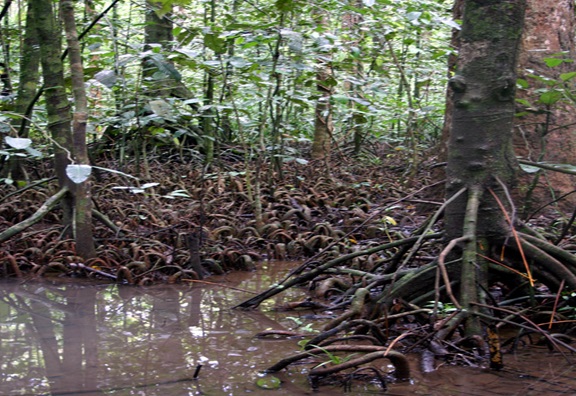|
Prelims
(Environmental Ecology, Biodiversity)
Mains
(General Studies Paper- 3 : Conservation, Environmental Pollution and Degradation, Environmental Impact Assessment)
|
Reference
Recently, a few kilometres from the Goa-Maharashtra border, researchers discovered a sacred grove called ‘Myristica Swamp Forest’ at Kumbral which is preserved by the local community.

About Myristica Magnifica Swamp Forest
- Introduction: It is a type of freshwater swamp forest composed mainly of species of Myristica.
- Myristica is a plant species found in Karnataka and Kerala, which is classified in the endangered (EN) category in the Red List of IUCN.
- This plant grows in swampy habitats along the rivers in evergreen forests.
- Earlier this type of forest was found in Bambarde village of Sindhudurg district of Maharashtra. In this way, Kumbral has become the second village in Maharashtra where such a forest has been found.
- Details: This sacred grove is spread over 8,200 square meters, in which 39 species of plants have been documented. The dominant presence of 70 species in the swamp forest is of Myristica Magnifica.
- Religious significance: It has been preserved by villagers for centuries in the name of Lord Shiva, locally known as Bhalandeshwar.
- Environmental significance: It provides habitat for various species like hornbill, endangered Asian small clawed otter, etc.
- This patch of Myristica swamp forest provides several ecosystem services like groundwater recharge, carbon sequestration, natural barrier against floods, habitat and food for various aquatic faunal species.
|
Swamp Forest
- Freshwater swamp forests are a type of wetland ecosystem.
- These forests are typically found in low-lying areas, riverbanks and floodplains where there is a constant supply of freshwater.
- These forests are rich in biodiversity and provide habitat for a wide variety of plant and animal species.
- These forests act as natural sponges against flooding by absorbing excess water during heavy rainfall. Also, they help improve water quality by filtering water and removing pollutants.
- These forests are important in mitigating the effects of climate change as carbon sinks.
- Local communities often depend on them for resources such as timber, non-timber forest products (such as fruit, honey) and fish.
- These forests are vulnerable to logging due to urbanisation, development, drainage and agriculture.
|
Sacred Grove
- Sacred groves are forest areas protected by local communities, which usually have special religious significance for the protecting community. This is a belief based on the principle of nature worship.
- Such beliefs have preserved many perennial forests in their pristine form. These sacred groves are also called groves of gods and goddesses.
- Sacred groves are land areas with natural vegetation, which have been protected since ancient times on religious and cultural grounds. These areas are found in the north-eastern Himalayas, Western Ghats, Eastern Ghats, coastal areas, central plateau and western parts of India.
- Any kind of interference in these patches of forest is prohibited. However, other forms of forest use such as honey collection and dry wood collection are sometimes permitted on a permanent basis.
- In India, sacred groves are legally protected as ‘community reserves’ under the Wildlife (Protection) Amendment Act, 2002.
- Historically, sacred groves are mentioned in Hindu, Jain and Buddhist scriptures. They are known by different names in different states:
|
State
|
Name
|
|
Andhra Pradesh
|
pavitrakshetralu
|
|
Arunachal Pradesh
|
Gumpa van
|
|
Assam
|
Than, Madaiko
|
|
Chhattisgarh
|
Sarna, Devlas, Mandar, Budhadev
|
|
Hariyaana
|
Beed or Boli, Bani, Bann(Ban), Jangalat, Shamlat
|
|
Himachal Pradesh
|
Dev Kothi, Devban, Bakhu Devban
|
|
Jharkhand
|
Sarna
|
|
Karnataka
|
Devarakadu, Devakad
|
|
Kerala
|
Kavu, Sarpa Kaavu
|
|
Maharashtra
|
Devrai
|
|
Manipur
|
umang layi, Gamkhaap, Mohawk
|
|
Odisha
|
jahera, Thakuramma
|
|
Tamil Nadu
|
Kovil Kadu
|
|
Uttarakhand
|
Devbhoomi, boun, Bugyal
|
|
West Bengal
|
Garamthan, Harithan, jahera, Sabitrithan
|
|
Rajasthan
|
Oran (Jaisalmer, Jodhpur, Bikaner), Kenkari (Ajmer), Vani (Mewar), Shamlat Deeh, Devbani (Alwar), Jogmaya
|
|
Sacred grove
- This is an environmental concept. In Marathi language it is known as 'Devrai' and in foreign countries it is known as 'Church Forest'.
- These areas are rich in biodiversity and are also the habitat of many important species. These areas are mostly located near a perennial water source.
- Even today many communities in India worship trees and protect them. Gond community does not cut green trees.
|



